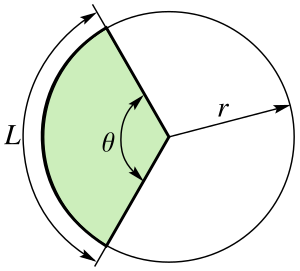Arc (geometry)

A circular sector is shaded in green. Its curved boundary of length L is a circular arc.
In Euclidean geometry, an arc (symbol: ⌒) is a closed segment of a differentiable curve. A common example in the plane (a two-dimensional manifold), is a segment of a circle called a circular arc. In space, if the arc is part of a great circle (or great ellipse), it is called a great arc.
Every pair of distinct points on a circle determines two arcs. If the two points are not directly opposite each other, one of these arcs, the minor arc, will subtend an angle at the centre of the circle that is less than π radians (180 degrees), and the other arc, the major arc, will subtend an angle greater than π radians.
Contents
1 Circular arcs
1.1 Length of an arc of a circle
1.2 Arc sector area
1.3 Arc segment area
1.4 Arc radius
2 Parabolic arcs
3 See also
4 References
5 External links
Circular arcs
Length of an arc of a circle
The length (more precisely, arc length), L, of an arc of a circle with radius r and subtending an angle θ (measured in radians) with the circle center — i.e., the central angle — equals θr. This is because
- Lcircumference=θ2π.{displaystyle {frac {L}{mathrm {circumference} }}={frac {theta }{2pi }}.}
Substituting in the circumference
- L2πr=θ2π,{displaystyle {frac {L}{2pi r}}={frac {theta }{2pi }},}
and, with α being the same angle measured in degrees, since θ = α/180π, the arc length equals
- L=απr180.{displaystyle L={frac {alpha pi r}{180}}.}
A practical way to determine the length of an arc in a circle is to plot two lines from the arc's endpoints to the center of the circle, measure the angle where the two lines meet the center, then solve for L by cross-multiplying the statement:
- measure of angle in degrees/360° = L/circumference.
For example, if the measure of the angle is 60 degrees and the circumference is 24 inches, then
- 60360=L24360L=1440L=4.{displaystyle {begin{aligned}{frac {60}{360}}&={frac {L}{24}}\360L&=1440\L&=4.end{aligned}}}
This is so because the circumference of a circle and the degrees of a circle, of which there are always 360, are directly proportional.
Arc sector area
The area of the sector formed by an arc and the center of a circle (bounded by the arc and the two radii drawn to its endpoints) is
- A=r2θ2.{displaystyle A={frac {r^{2}theta }{2}}.}
The area A has the same proportion to the circle area as the angle θ to a full circle:
- Aπr2=θ2π.{displaystyle {frac {A}{pi r^{2}}}={frac {theta }{2pi }}.}
We can cancel π on both sides:
- Ar2=θ2.{displaystyle {frac {A}{r^{2}}}={frac {theta }{2}}.}
By multiplying both sides by r2, we get the final result:
- A=12r2θ.{displaystyle A={frac {1}{2}}r^{2}theta .}
Using the conversion described above, we find that the area of the sector for a central angle measured in degrees is
- A=α360πr2.{displaystyle A={frac {alpha }{360}}pi r^{2}.}
Arc segment area
The area of the shape bounded by the arc and the straight line between its two end points is
- 12r2(θ−sinθ).{displaystyle {frac {1}{2}}r^{2}left(theta -sin {theta }right).}
To get the area of the arc segment, we need to subtract the area of the triangle, determined by the circle's center and the two end points of the arc, from the area A{displaystyle A}
Arc radius

The product of the line segments AP and PB equals the product of the line segments CP and PD. If the arc has a width AB and height CP, then the circle's diameter CD=AP⋅PBCP+CP{displaystyle CD={frac {APcdot PB}{CP}}+CP}

Using the intersecting chords theorem (also known as power of a point or secant tangent theorem) it is possible to calculate the radius r of a circle given the height H and the width W of an arc:
Consider the chord with the same endpoints as the arc. Its perpendicular bisector is another chord, which is a diameter of the circle. The length of the first chord is W, and it is divided by the bisector into two equal halves, each with length W/2. The total length of the diameter is 2r, and it is divided into two parts by the first chord. The length of one part is the sagitta of the arc, H, and the other part is the remainder of the diameter, with length 2r − H. Applying the intersecting chords theorem to these two chords produces
- H(2r−H)=(W2)2,{displaystyle H(2r-H)=left({frac {W}{2}}right)^{2},}
whence
- 2r−H=W24H,{displaystyle 2r-H={frac {W^{2}}{4H}},}
so
- r=W28H+H2.{displaystyle r={frac {W^{2}}{8H}}+{frac {H}{2}}.}
Parabolic arcs
See also
- Biarc
- Circular-arc graph
- Meridian arc
- Circumference
- Perimeter
References
External links
| Wikimedia Commons has media related to Circle arcs. |
- Table of contents for Math Open Reference Circle pages
Math Open Reference page on circular arcs With interactive animation
Math Open Reference page on Radius of a circular arc or segment With interactive animation- Weisstein, Eric W. "Arc". MathWorld..mw-parser-output cite.citation{font-style:inherit}.mw-parser-output .citation q{quotes:"""""""'""'"}.mw-parser-output .citation .cs1-lock-free a{background:url("//upload.wikimedia.org/wikipedia/commons/thumb/6/65/Lock-green.svg/9px-Lock-green.svg.png")no-repeat;background-position:right .1em center}.mw-parser-output .citation .cs1-lock-limited a,.mw-parser-output .citation .cs1-lock-registration a{background:url("//upload.wikimedia.org/wikipedia/commons/thumb/d/d6/Lock-gray-alt-2.svg/9px-Lock-gray-alt-2.svg.png")no-repeat;background-position:right .1em center}.mw-parser-output .citation .cs1-lock-subscription a{background:url("//upload.wikimedia.org/wikipedia/commons/thumb/a/aa/Lock-red-alt-2.svg/9px-Lock-red-alt-2.svg.png")no-repeat;background-position:right .1em center}.mw-parser-output .cs1-subscription,.mw-parser-output .cs1-registration{color:#555}.mw-parser-output .cs1-subscription span,.mw-parser-output .cs1-registration span{border-bottom:1px dotted;cursor:help}.mw-parser-output .cs1-ws-icon a{background:url("//upload.wikimedia.org/wikipedia/commons/thumb/4/4c/Wikisource-logo.svg/12px-Wikisource-logo.svg.png")no-repeat;background-position:right .1em center}.mw-parser-output code.cs1-code{color:inherit;background:inherit;border:inherit;padding:inherit}.mw-parser-output .cs1-hidden-error{display:none;font-size:100%}.mw-parser-output .cs1-visible-error{font-size:100%}.mw-parser-output .cs1-maint{display:none;color:#33aa33;margin-left:0.3em}.mw-parser-output .cs1-subscription,.mw-parser-output .cs1-registration,.mw-parser-output .cs1-format{font-size:95%}.mw-parser-output .cs1-kern-left,.mw-parser-output .cs1-kern-wl-left{padding-left:0.2em}.mw-parser-output .cs1-kern-right,.mw-parser-output .cs1-kern-wl-right{padding-right:0.2em}














Comments
Post a Comment